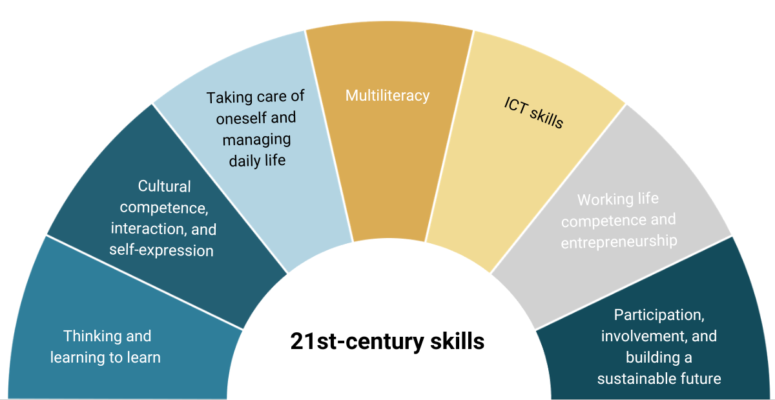A core principle of Finnish education model is to support students’ growth as individuals, enhance skills necessary for participating in tomorrow’s democratic society and make sustainable choices regardless of your age. This requires knowledge and competences that crosses boundaries and connects different fields of knowledge.
Finnish National Core Curriculum for Basic Education (2014) contains objectives, core content and evaluation criteria of all school subjects. It also introduces seven transversal competencies integrated into all subjects and school activities. These so-called 21st-century skills are tools that can be universally applied to enhance ways of thinking, learning, working and living in the world.
Our blog series will unlock the secrets of 21st-century skills:

21st-century skills – 2. Cultural competence, interaction, and self-expression
Understanding and respecting other cultures and backgrounds is essential in today’s globalized society. Having a curious mind helps.
Globalization and internationalization have led to people interacting with different cultures, traditions, philosophical views, religions, and languages on a daily bases in schools. Life today requires acceptance and understanding of different cultural backgrounds as well as advanced emotional and social interaction skills.
No matter how different or strange someone’s thoughts or behavior might be, we need to remember to respect their human rights. It’s essential for students to be exposed to their backgrounds, build their cultural identity and explore the cultures of others.
Teaching students about respectful interaction, expression, and participation is important for creating value in diversity and self-expression. It’s about how to communicate in different situations and towards younger or older people. There is not a one formula for great communication skills, but there are various ways to develop that skill. Students should be introduced to various forms of cultural expression: art, music, language, and religion. Offering diverse opportunities for self-expression develops a student’s maturity, empathy, and emotional intelligence with communication skills.
It’s also important to teach the ability to identify and express emotions to guide students’ responses in different situations as well as understand why others react as they do. This 21st-century skill could be taught to students as a part of a teamwork exercise in Environmental Studies where students give feedback to each other from the work they did about recycling, e.g., how it feels to give and receive constructive and positive feedback. Other great example for lessons topic is to let student’s to showcase their cultural identity and family heritage with art, music, language or religion – e.g. why and how certain music is part of their celebrations or what is their way to draw or paint a person or family.
Personal connection makes for deeper learning
A key to increasing cultural literacy is learning a second language. Almost all schools include foreign languages in their curriculum. However, many lessons rely on simple words and grammar memorization. This kind of learning lacks connection with students’ personal lives and interests. Statistics show that people remember new information better when it is associated with personal experience. Here is a story shared by a Spanish teacher:
There are a lot of opportunities to personalize students’ language experience. I always try to find out about their interests to improve my lessons. Some students are into Spanish legends, some prefer to discuss world news and others just like to talk about themselves. Shared points of interest make my students dive into a language environment and learn more words, grammar, and so on, even without noticing it.
Through various forms of culture, languages, and art, students engage with others’ cultures and develop their unique way of communication and self-expression.
This article is part of our series about 21st-century skills, a crucial theme in the future of education. See other parts of this series below:
- Part 1: Thinking and learning to learn
- Part 2: Cultural competence, interaction, and self-expression
- Part 3: Taking care of oneself and managing daily life
- Part 4: Multiliteracy
- Part 5: ICT skills
- Part 6: Working life competence and entrepreneurship
- Part 7: Participation, involvement, and building a sustainable future
